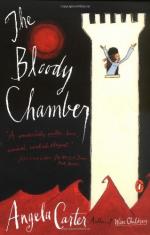|
This section contains 1,956 words (approx. 5 pages at 400 words per page) |

|
Kaiser teaches English at Jefferson State Community College in Birmingham, Alabama. In the following excerpt, she examines Carter's use of intertextuality and the sexual symbolism in "The Bloody Chamber."
As Carter suggests in her introduction to The Old Wives' Fairy Tale Book, intertextuality was embedded into the history of the fairy tale when Charles Perrault, the Grimm Brothers, and other compilers of the eighteenth and nineteenth centuries transposed oral folk tales into fairy tales. This transfer involved what [Julia] Kristeva refers to as "a new articulation of the thetic," as the politics, economics, fashions, and prejudices of a sophisticated culture replaced the values of rural culture that form the context of oral folklore [Revolution in Poetic Language, 1990]. Part of this transfer, Carter argues, was the transposing of an essentially feminine form, the "old wives' tale," onto a masculine one, the published text. Referring to the tradition of...
|
This section contains 1,956 words (approx. 5 pages at 400 words per page) |

|




